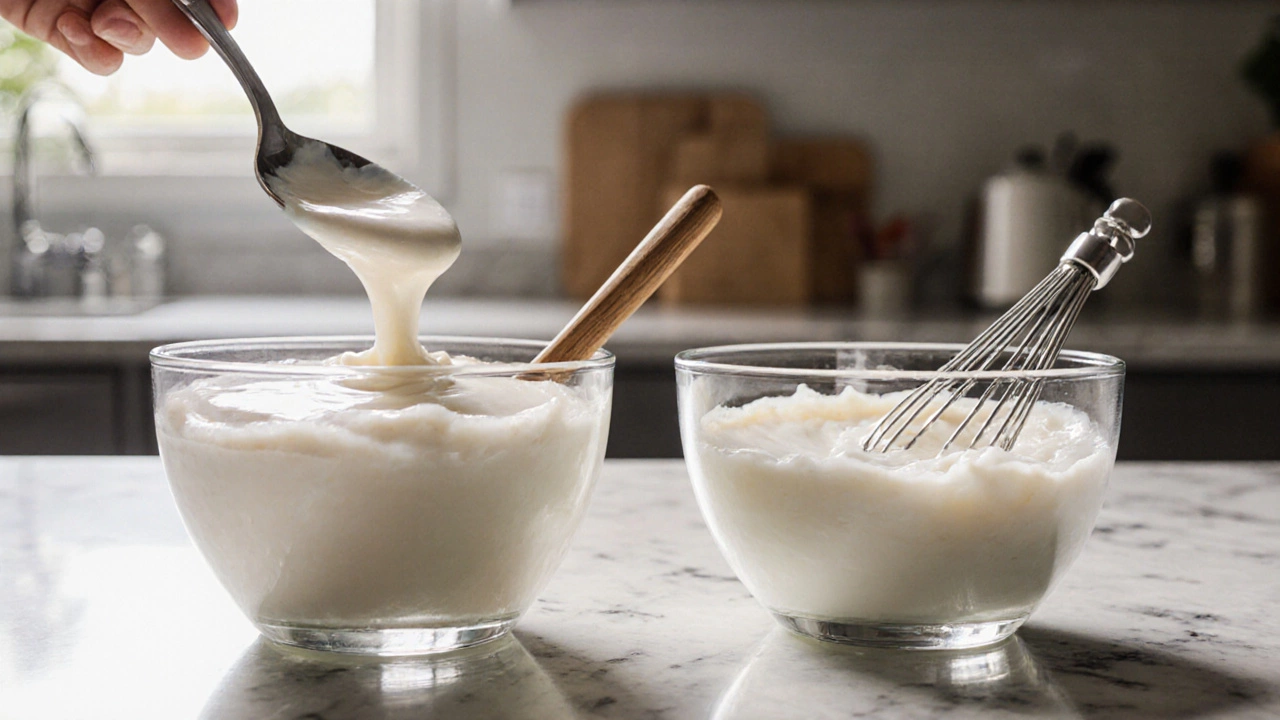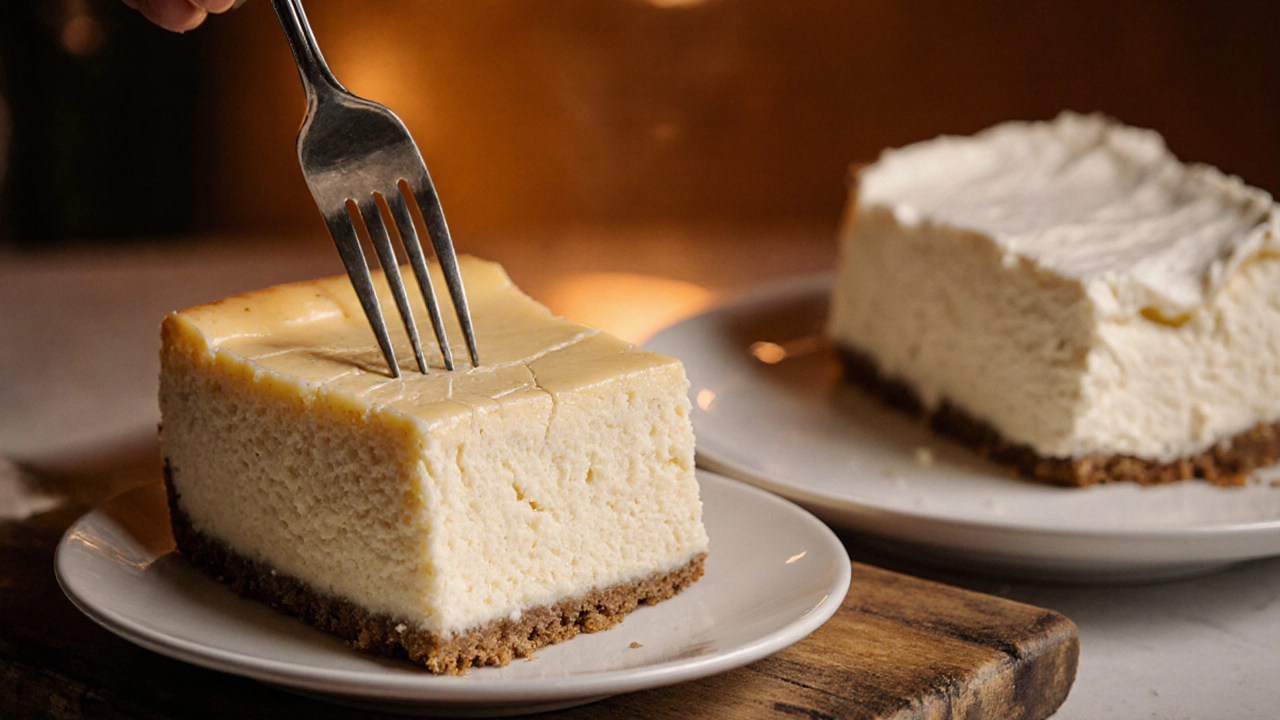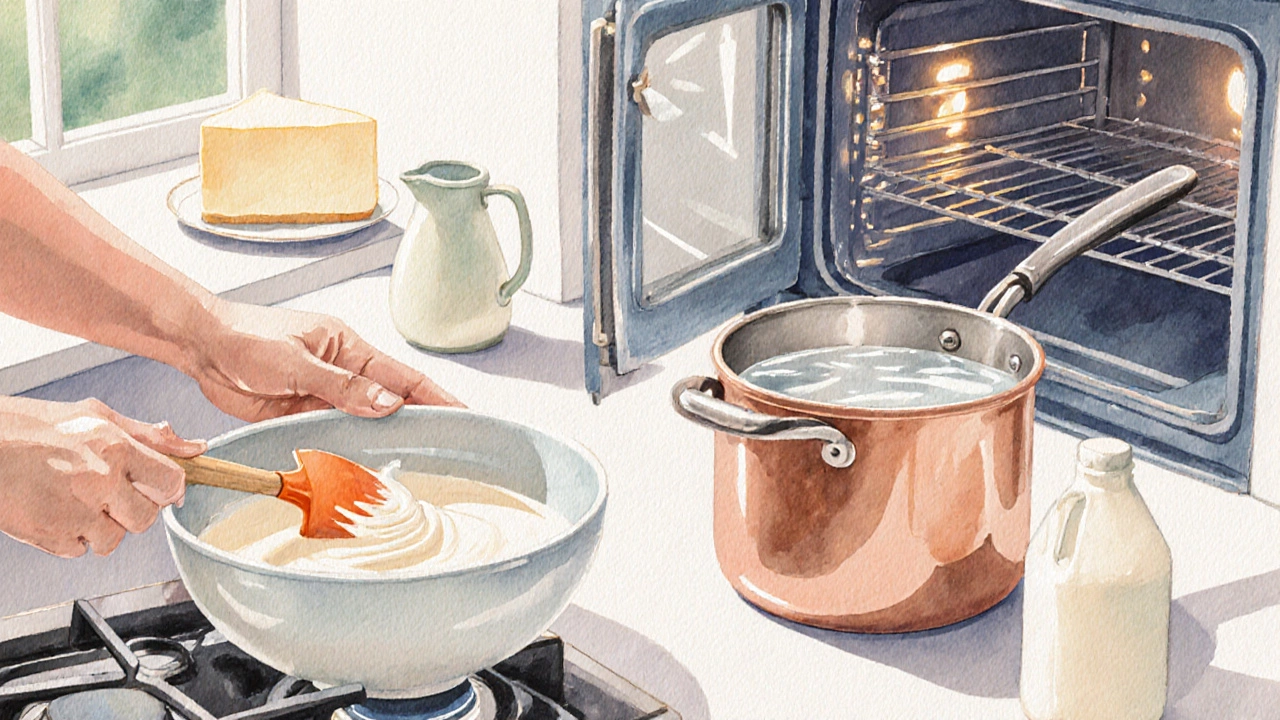
Cheesecake Cream Selector
Choose Your Cheesecake Style
Your Texture Preference
When you’re chasing the perfect cheesecake, the kind of cream you stir in can make a world of difference. The age‑old debate of double cream vs whipping cream often pops up in forums, but does one really give a richer, smoother slice? Below we break down the science, the texture, and the practical side so you can decide which cream belongs in your next batter.
Key Takeaways
- Double cream contains around 48% butterfat, while whipping cream sits near 35%.
- Higher fat means double cream produces a denser, creamier mouthfeel and less risk of curdling during baking.
- Whipping cream works well when you need a lighter texture or plan to fold in whipped peaks.
- Temperature control and gentle mixing are more critical with whipping cream to avoid grainy cheese.
- For most classic New York‑style cheesecakes, double cream is the safer bet; for airy, mousse‑like versions, whipping cream can shine.
Understanding the Two Creams
Double cream is a British dairy product that typically contains 48% butterfat, making it one of the richest cream types available. Its thick, spoon‑able consistency means it can be ladled straight onto desserts without whipping. It was first commercialised in the early 20thcentury and is a staple in UK sauces and desserts.
Whipping cream usually carries about 35% butterfat. This lower fat level allows it to trap air when beaten, turning into a fluffy foam that holds its shape for piping or topping. In the US it’s often called heavy cream, though “heavy cream” can also refer to a slightly higher‑fat version (up to 40%).
Fat Content, Butterfat, and Texture
Butterfat is the component that gives cream its richness. The more butterfat, the smoother the melt‑in‑your‑mouth feeling. Double cream’s 48% butterfat creates a silkier custard base, while whipping cream’s 35% delivers a lighter structure. When mixed with cream cheese, the fat in the cream helps prevent the cheese from tightening up as it bakes.
During baking, proteins in cream cheese coagulate. If the surrounding liquid has too little fat, the proteins pull tighter, resulting in a grainy or cracked surface. The extra butterfat in double cream coats these proteins, reducing tension and giving a more uniform crumb.
How Cream Choice Influences Cheesecake
Here’s what you’ll notice in the final cake depending on which cream you use:
- Density: Double cream adds mass without adding air, leading to a denser, almost custard‑like interior. Whipping cream, especially when beaten, incorporates air that creates a lighter, mousse‑style texture.
- Crack‑Resistance: A higher‑fat cream lowers the chance of a surface crack because the mixture expands less dramatically during cooling.
- Mouthfeel: Double cream gives a buttery, luxurious melt; whipping cream feels airy and less heavy.
- Flavor Balance: The buttery notes of double cream complement tangy cream cheese, while whipping cream lets the cheese’s acidity shine.

Practical Test: Double Cream vs Whipping Cream
We baked two identical NewYork‑style cheesecakes, swapping only the cream. Both used 300g cream cheese, 100g sugar, 2eggs, and a vanilla bean. One batch received 150ml double cream, the other 150ml whipping cream (un‑whipped).
Results after a 4‑hour chill:
- The double‑cream cheesecake held a firm, smooth slice that didn’t wobble. The surface was glossy and crack‑free.
- The whipping‑cream version was noticeably lighter, with a softer set that gave a slight wobble when the plate was nudged. A faint crack appeared near the edge after cooling.
Both tasted good, but the double‑cream version felt richer and more indulgent, while the whipping‑cream cake felt airy and less filling.
When to Choose Double Cream
If you’re aiming for a classic, dense cheesecake-think NewYork, Basque burnt, or a rich Chicago style-double cream is your go‑to. It’s also ideal when the recipe calls for a “heavy” cream that can stand up to a high‑temperature bake without separating.
Use double cream when:
- You want a smooth, creamy texture with minimal cracking.
- The recipe includes a high sugar load that could destabilise lower‑fat cream.
- You’re adding flavors like caramel or chocolate that benefit from extra fat for better mouthfeel.
When Whipping Cream Shines
Whipping cream is perfect for cheesecakes that lean toward a mousse or soufflé style, where a lift is desirable. It also works well in no‑bake cheesecakes that rely on chilling to set, especially when you whip the cream to soft peaks before folding.
Choose whipping cream when:
- You desire a lighter, airy bite.
- The recipe includes a folded meringue or whipped topping that already adds air.
- You’re working with a low‑fat cream cheese (e.g., reduced‑fat) and need the extra fat for richness.
Comparison Table
| Attribute | Double Cream | Whipping Cream |
|---|---|---|
| Butterfat | ~48% | ~35% |
| Typical Use | Dense, rich cheesecakes | Light, airy cheesecakes or no‑bake |
| Crack Risk | Low | Higher if not whipped |
| Texture Impact | Silky, custard‑like | Fluffy, mousse‑like |
| Cost (UK) | Usually a bit more | Generally cheaper |

Pro Tips for the Perfect Cheesecake
- Temperature matters: Keep both cream and cream cheese chilled until you blend them. Warm ingredients can cause unwanted separation.
- Gentle mixing: Use a spatula to fold the cream into the cheese. Over‑mixing incorporates air, which can lead to cracks.
- Room‑temp eggs: Adding eggs at room temperature helps them emulsify better with the cream mixture.
- Water‑bath baking: A bain‑marie supplies even heat, reducing the chance of a cracked surface regardless of cream choice.
- Cool slowly: After baking, let the cheesecake sit in the oven with the door ajar for an hour before chilling. This gradual cool‑down minimizes cracking.
Common Mistakes & How to Fix Them
Over‑whipping the whipping cream can create large air bubbles that collapse during baking, leaving a speckled texture. If you notice this, gently fold the over‑whipped cream with a rubber spatula to break some bubbles before adding the cheese.
Using a low‑fat cream cheese with whipping cream often results in a thin, watery set. Remedy this by adding a tablespoon of cornstarch or a bit more double cream to boost fat.
Skipping the water bath is a frequent cause of a cracked top. If you forget it, you can rescue the cake by covering it with foil halfway through baking and lowering the oven temperature by 10°C.
Next Steps & Troubleshooting
Try the following quick experiments to see how each cream behaves in your kitchen:
- Make two 1‑cup batter samples: one with double cream, one with whipping cream (un‑whipped).
- Bake each in a small ramekin at 160°C for 25minutes in a water bath.
- Cool them on a wire rack, then chill for two hours. Compare texture, firmness, and crack formation.
If the whipping‑cream batch feels too loose, increase the butterfat by using a “heavy whipping cream” (around 38% fat) or blend in a splash of double cream.
When using double cream but still getting cracks, check your oven temperature with an external probe-many ovens run hotter than the dial suggests, which can over‑cook the edges.
Frequently Asked Questions
Can I substitute half‑and‑half for double cream in a cheesecake?
Half‑and‑half contains about 12% butterfat, far lower than double cream. It will make the filling noticeably thinner and increase the risk of cracks. If you must use it, boost the fat by adding a couple of tablespoons of melted butter or a splash of heavy cream.
Do I need to whip the whipping cream before folding it into the batter?
For most baked cheesecakes, you want the cream in its liquid state to keep the batter smooth. Whipping it first adds air that can collapse in the oven, creating holes. Only whip when the recipe calls for a mousse‑style, no‑bake version.
Is there a noticeable flavor difference between the two creams?
Both are dairy‑sweet, but double cream carries a richer, buttery note because of the higher fat. Whipping cream feels lighter on the palate, letting the cheese’s tang come forward.
Can I use double cream in a no‑bake cheesecake?
Yes, double cream works well in no‑bake recipes. It adds luxury without needing to be whipped, so you just fold it into softened cream cheese, sugar, and any flavorings, then chill.
What’s the best way to store leftover double cream?
Keep it in its original container, tightly sealed, in the coldest part of the fridge (usually the bottom shelf). It will stay fresh for about a week. If you notice a sour smell, discard it.